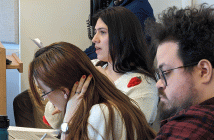Redistricting, an essential aspect of American democracy, need not be a mystery to the public, a panel of experts said on Oct. 5 at the Lincoln Center campus.
The panel kicked off the 2012 New York Redistricting Project, a collaborative effort between Fordham, George Mason and Harvard universities that is funded by a grant from the Alfred P. Sloan Foundation.
The discussion series will continue at five locations throughout the state, where experts will address key elements and issues related to redistricting. After that, the project will award a $1,000 prize to a college team that submits its own congressional, state assembly or state senate district map.
“For too long, ordinary citizens have lacked awareness of the principles affecting redistricting and have been effectively left out of the decennial process,” said Costas Panagopoulos, Ph.D., professor of political science and director of the Center for Electoral Politics and Democracy at Fordham.
“This year our mission is to change all that. It has never been easier to be involved in the redistricting process,” he said.
The panel addressed two aspects of redistricting, which happens every 10 years, in conjunction with the United States Census: Who does it; and how it’s done.
story continues below

Nathaniel Persily, Ph.D., (center) says that efforts are underway to count prisoners as members of their former districts, and not the districts where they are incarcerated. Photo by Bruce Gilbert
Panelists noted that although it can seem arcane, the process is extremely important because it determines who Americans will send to the U.S. House of Representatives and their own statehouses.
In New York, the process—which is also known as “gerrymandering”—has been criticized because legislators have used it to ensure the districts they represent are drawn in a way that snuffs out competition.
Dick Dadey, executive director of the government watchdog group Citizens Union, categorized the process in New York between the Democratically held Assembly and the Republican-held Senate as: “Don’t play in my sandbox, and I won’t play in yours.”
“Citizens Union, along with many other groups, have wanted to change that process,” he said.
“We wanted to remove the conflict of interest that exists when legislators get to draw their own lines,” he said. “Essentially what happens in partisan gerrymandering is that legislators in smoke-filled back rooms get to pick the voters before the voters choose them.”
Convincing lawmakers to voluntarily give up power is extraordinarily difficult, but Dadey said that political momentum was building to the point where an independent commission might be possible.
In 2006, Citizens Union received assurances from gubernatorial candidates that they would veto district lines not drawn by an independent commission. Andrew Cuomo, who was the New York state attorney general at the time, threw his support behind the idea and has continued it as governor.
“Because of the governor’s veto threat, we are now seeing serious negotiations in a way that was unimaginable just a year ago, when many people thought, ‘You’re not going to be able to change the system,’” Dadey said.

Costas Panagopoulos, Ph.D., says the Center for Electoral Politics and Democracy seeks to involve ordinary citizens in the redistricting process. Photo by Bruce Gilbert
Nathaniel Persily, Ph.D., the Charles Keller Beekman Professor of Political Science at Columbia University Law School, served on such a commission during the redistricting process in 2001.
Several factors come into play during redistricting, he said, notably two sections of the 1965 Federal Voting Rights Act, which prohibits the dilution of minority votes. Efforts to have prisoners counted in their pre-incarceration address, and not where they’re jailed, are also underway.
Michael McDonald, Ph.D., associate professor of government and politics at George Mason University, touted the online tool www.publicmapping.org, as something the public can use to shame recalcitrant legislators into doing the right thing.
Two common methods that partisans wield against opponents during redistricting is to dilute their supporters by splitting them into separate districts, or by lumping them into one district surrounded by opposing ones.
Michael Halberstam, Ph.D., a professor at the State University of New York at Buffalo Law School, said it is important to remember there are no correct ways to draw districts.
A district drawn to protect an incumbent politician might seem undemocratic, but if it ensures that a minority group’s representative serves in Congress long enough to earn a high-ranking committee assignment, then that might be seen as positive.
“Judgments will always be made, and those judgments will depend on the theory of democracy,” he said. “But what does seem very objectionable—and hence this idea of the democratic legitimacy of the process—is the idea that when legislators get to draw their own boundaries then they decide the outcome of the elections.”
The winner of the project’s student contest will be announced on Monday, Dec. 12, at a ceremony at Fordham. For more information visit http://www.redistrictny.org/.


